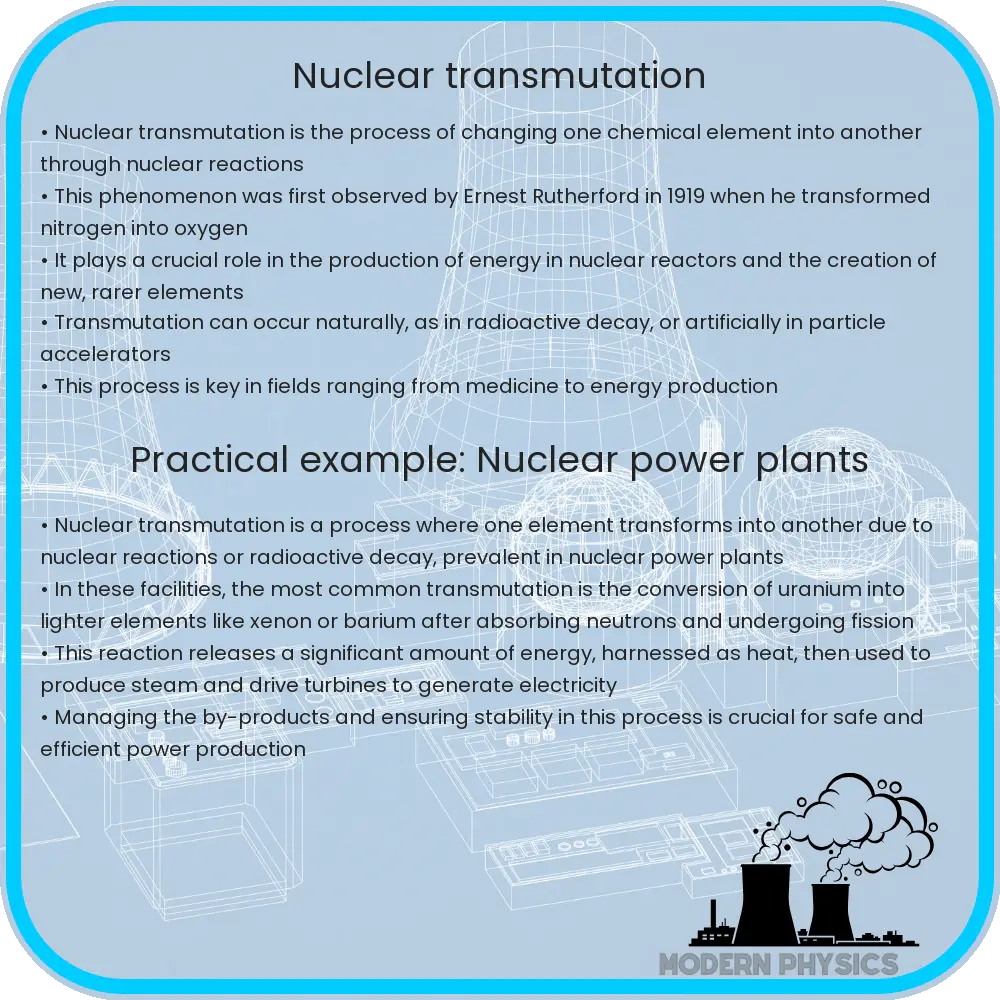Nuclear transmutation involves changing one chemical element or isotope into another via natural or artificial processes in nuclear physics.

Understanding Nuclear Transmutation: The Alchemy of Elements
Nuclear transmutation is a fundamental concept in nuclear physics involving the conversion of one chemical element or isotope into another. This process can occur naturally in stellar environments or be induced artificially in laboratories or nuclear reactors. Understanding nuclear transmutation not only unravels the complexities of atomic behavior but also highlights its profound implications in various scientific and practical fields.
The Process of Nuclear Transmutation
Nuclear transmutation occurs through various types of nuclear reactions, including nuclear fusion, fission, and radioactive decay. Each method involves different mechanisms and conditions:
- Nuclear Fusion: This process involves combining two or more lighter nuclei to form a heavier nucleus, releasing a significant amount of energy. Fusion is the process powering the sun and other stars, where hydrogen nuclei combine to form helium.
- Nuclear Fission: Conversely, fission involves the splitting of a heavy nucleus into lighter nuclei along with the release of energy and neutrons. This process is employed in nuclear reactors and atomic bombs.
- Radioactive Decay: Certain isotopes are inherently unstable and undergo spontaneous transformation into more stable nuclei. This decay can change one element into another and is characterized by the emission of alpha particles, beta particles, or gamma rays.
Induced transmutation, particularly prominent in scientific research and nuclear reactors, involves bombarding a nucleus with neutrons, protons, or other particles. For example, when a uranium-235 (^235U) nucleus absorbs a neutron, it becomes uranium-236 (^236U), which is highly unstable and typically undergoes fission into lighter elements and additional neutrons.
Significance of Nuclear Transmutation
Nuclear transmutation holds key significance in multiple domains:
- Energy Production: Both nuclear fusion and fission are harnessed to produce electricity. Modern nuclear reactors, using controlled fission reactions, supply a significant portion of the world’s electricity without emitting greenhouse gases during operation.
- Medical Applications: Radioisotopes produced through transmutation are crucial in medical diagnostics and treatment. For instance, cobalt-60, created from cobalt-59 by neutron bombardment, is extensively used in cancer radiotherapy.
- Scientific Research: Transmutation helps scientists create new elements and isotopes, contributing to our understanding of the atomic nucleus and particle interactions. The discovery of technetium-97 by artificial transmutation was a milestone in expanding the periodic table.
The principle of nuclear transmutation also extends to efforts in nuclear waste management. Transmuting long-lived radioactive isotopes into shorter-lived or stable ones can significantly reduce the challenges and dangers associated with nuclear waste disposal.
Challenges and Future Prospects in Nuclear Transmutation
Despite the significant benefits, nuclear transmutation poses several challenges that need to be addressed to maximize its potential:
- Technical Complexity: The intricate machinery and profound knowledge required to initiate and control nuclear reactions make transmutation a complex and expensive process. Maintaining the safety standards of the facilities involved adds an additional layer of complexity.
- Radiation Risks: Handling radioactive materials carries inherent risks. Adequate measures must be taken to protect workers and the environment from radiation exposure, which can have long-term health effects.
- Regulatory and Ethical Issues: The use of nuclear technology in any form involves rigorous regulatory scrutiny to avoid potential misuse and ensure public safety, posing considerable operational restrictions and delays.
Looking to the future, advancements in technology and materials science may hold the key to overcoming these challenges. Innovations such as smaller, safer modular reactors and more efficient waste recycling techniques could revolutionize the field. Additionally, ongoing research into fusion technology, often hailed as the ‘holy grail’ of energy production, promises an almost inexhaustible source of energy, with minimal byproduct and lower radioactive waste compared to fission reactors.
Conclusion
Nuclear transmutation plays a pivotal role in modern science and technology, offering solutions to some of the most pressing issues, from energy production to medical treatments and waste management. However, its application comes with significant challenges that require continuous innovation and stringent safety protocols. As researchers and engineers work towards more sustainable and safer methods of nuclear transmutation, we may see a new era of nuclear science that could provide cleaner energy and new materials, profoundly impacting our lives and the environment.
The journey of understanding and harnessing nuclear transmutation is a perfect example of how human curiosity and ingenuity can transform fundamental scientific concepts into practical applications that benefit society. Exploring this remarkable field further not only feeds our thirst for knowledge but also propels us towards a safer and more sustainable future.
